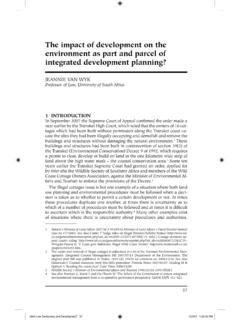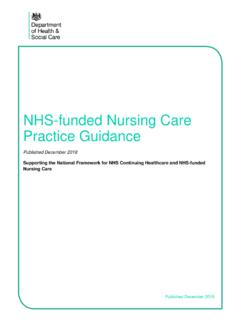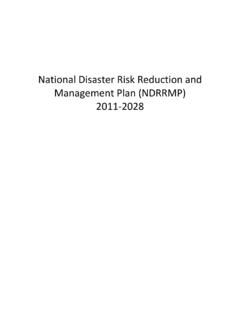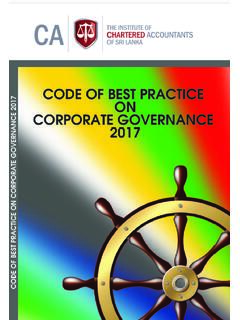Transcription of Preventing a Disaster Within the Disaster: The Effective ...
1 The Effective Use and Management of Unaffiliated Volunteers WHETHER YOU REPRESENT BUSINESS, GOVERNMENT, PHILANTHROPY or the nonprofit sector, you can play an important role in supporting efforts to engage volunteers more effectively in times of Disaster . The recommendations outlined in this report show how you can contribute to the safety, security and well-being of our nation and local communities. On September 11, 2001, spontaneous volunteers hit the country s radar screen. We need a national agenda to include volunteer management in every community s emergency plan.
2 - Margaret Melsh Disaster Response Program Manager The Volunteerism Project It is a paradox people s willingness to volunteer versus the system s capacity to use them effectively. - Tom Weidemeyer Chief Operating Officer of United Parcel Service and President, UPS Airlines Volunteer management is too often an afterthought. A more structured approach is required, particularly when hundreds or thousands of volunteers want to be engaged. - Scott Ingram Director of Community Services Volunteer Center of Tucson Volunteers, especially Disaster volunteers, face challenges similar to members of the emergency management community being unable to give as much as they wanted.
3 - Jim Schwartz Deputy Assistant Chief of Operations Arlington County Fire Department and Incident Commander September 11, 2001, Pentagon site The Points of Light Foundation & Volunteer Center National Network, UPS, and the Federal Emergency Management Agency would like to thank the organizations and individuals that con tributed to the creation of this report. No community is immune to the havoc and devastation caused by Disaster , whether natural or man-made. When Disaster strikes, emergency management and voluntary agencies automatically mobilize. Each has a specific role to help ensure a community s successful response to and recovery from the Disaster s devastation.
4 Yet, one element Within the present system continues to challenge this process: Spontaneous, unaffiliated volunteers. These volunteers our neighbors and everyday citizens are eager to respond and contribute to the community s recovery, but usually lack the training to help them be Effective in these roles. Unaffiliated volunteers often arrive on-site in numbers too great for traditional Disaster responders emergency management, Disaster relief agency staff, and affiliated volunteers to manage as they try to meet the immediate needs of communities affected by Disaster . The challenge, therefore, is reconciling the desire to help felt by unaffiliated volunteers with the need of responder s to do their jobs unencumbered by the responsibility of managing volunteers.
5 Disaster volunteering refers to all volunteer activities performed during any phase of the emergency management cycle. Spontaneous or unaffiliated volunteers are individuals or groups that: arrive unsolicited at the scene of a Disaster may or may not be a resident of the affected community may or may not possess skills necessary to respond to the current Disaster are not associated with any part of the existing emergency management response system Disaster Site refers to the general area in community damaged by the Disaster . THOUGH SPONTANEOUS, UNAFFILIATED VOLUNTEERS HAVE BEEN A significant obstacle in past Disaster response operations, our society can ill afford to ignore the potential capacity of its citizens to help improve conditions in their communities, especially in times of Disaster .
6 It is critical that these volunteers have meaningful and constructive opportunities to assist their communities in Preventing , preparing for, responding to, and recovering from Disaster . Collaborative planning by Disaster groups and other organizations can help ensure that we avoid creating a Disaster Within the Disaster . Preventing A Disaster Within THE Disaster 3 National Leadership Forum on Disaster Volunteerism In April 2002, UPS, the Points of Light Foundation & Volunteer Center National Network, and the Federal Emergency Management Agency (FEMA) convened the National Leadership Forum on Disaster Volunteerism.
7 The meeting brought together volunteer and emergency management leaders and operations experts to explore ways to strengthen our nation s ability to engage volunteers appropriately and effectively in all phases of Disaster . Over 90 people representing more than 45 organizations participated. Attendees identified challenges and opportunities associated with unaffiliated volunteers, developed initial recommenda tions for addressing the challenges and leveraging the opportunities, and committed to work toward the recommendations proposed. This report grew out of their experience, knowledge, and insight.
8 VISION FOR Disaster VOLUNTEERING - Created by participants of the National Leadership Forum on Disaster Volunteerism, April 2002. Disaster Volunteering is necessary for the recovery and healing of people and communities. Disaster Volunteer Coordination is an essential management function Within emergency management and should be fully integrated into emergency management systems at all levels. It is most successful when the full range of community resources and knowledge is leveraged, and when roles and responsibilities are clearly defined. Preventing A Disaster Within THE DISASTERB enefits of Effective Disaster Volunteer Management First responders can fulfill their duties without the added responsibility of managing volunteers.
9 Experienced volunteer coordinators can manage volunteers, to ensure meaningful and quality volunteer experiences. As a result, volunteers are more inclined to seek future community service opportunities. Voluntary organizations that are active in disasters can quickly and appropriately direct volunteers who became affiliated through mitigation and preparedness activities to additional areas of need in the Disaster cycle. Communities will know how to effectively engage citizens as volunteers in all phases of disasters. Communities can respond to and heal from disasters more effectively when volunteer efforts are well managed.
10 4 Effective and planned emergency volunteer management provides the opportunity to capture the inspiring, yet overwhelming, volunteer energy and interest that surfaces during the response phase. The envisioned Disaster volunteer management process is consistent with the comprehensive emergency management cycle and includes roles for volunteers in each phase mitigation, preparedness, response, and recovery. Moreover, the approach to volunteer management in any given phase of the cycle supports efforts in the next phase. This holistic approach engages volunteers in the mitigation and preparedness stages to help build more Disaster -resistant and well-equipped communities.


















